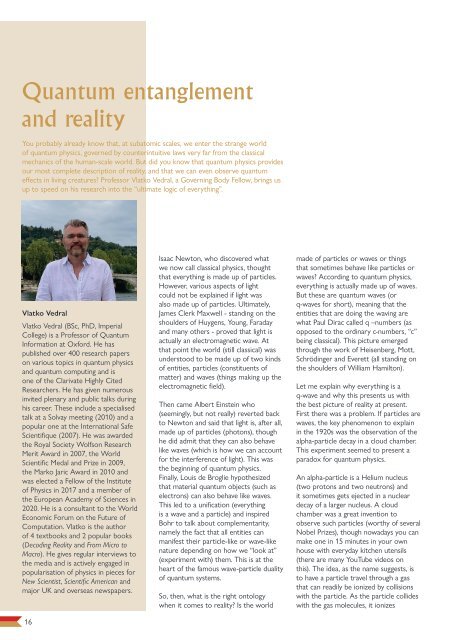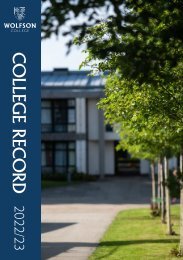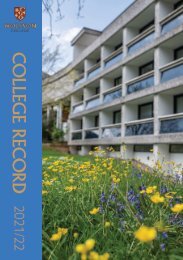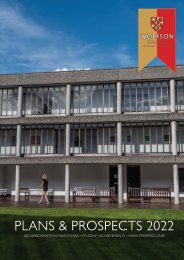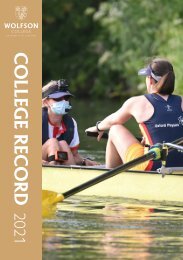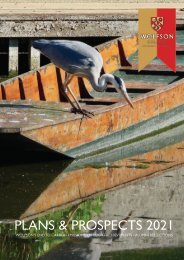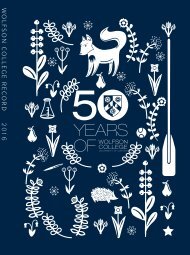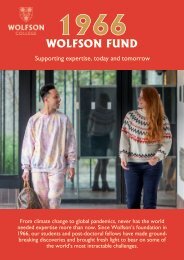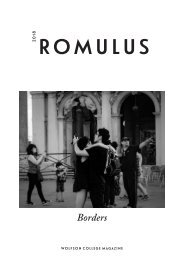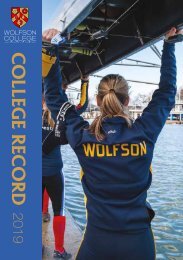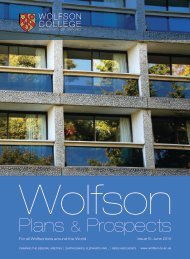Plans & Prospects 2023
Plans & Prospects is the annual magazine for alumni and friends of Wolfson College at the University of Oxford. We hope that you enjoy reading about life here at Wolfson, and welcome your feedback or article suggestions for next year's issue.
Plans & Prospects is the annual magazine for alumni and friends of Wolfson College at the University of Oxford. We hope that you enjoy reading about life here at Wolfson, and welcome your feedback or article suggestions for next year's issue.
Create successful ePaper yourself
Turn your PDF publications into a flip-book with our unique Google optimized e-Paper software.
Quantum entanglement<br />
and reality<br />
You probably already know that, at subatomic scales, we enter the strange world<br />
of quantum physics, governed by counterintuitive laws very far from the classical<br />
mechanics of the human-scale world. But did you know that quantum physics provides<br />
our most complete description of reality, and that we can even observe quantum<br />
effects in living creatures? Professor Vlatko Vedral, a Governing Body Fellow, brings us<br />
up to speed on his research into the “ultimate logic of everything”.<br />
Vlatko Vedral<br />
Vlatko Vedral (BSc, PhD, Imperial<br />
College) is a Professor of Quantum<br />
Information at Oxford. He has<br />
published over 400 research papers<br />
on various topics in quantum physics<br />
and quantum computing and is<br />
one of the Clarivate Highly Cited<br />
Researchers. He has given numerous<br />
invited plenary and public talks during<br />
his career. These include a specialised<br />
talk at a Solvay meeting (2010) and a<br />
popular one at the International Safe<br />
Scientifique (2007). He was awarded<br />
the Royal Society Wolfson Research<br />
Merit Award in 2007, the World<br />
Scientific Medal and Prize in 2009,<br />
the Marko Jaric Award in 2010 and<br />
was elected a Fellow of the Institute<br />
of Physics in 2017 and a member of<br />
the European Academy of Sciences in<br />
2020. He is a consultant to the World<br />
Economic Forum on the Future of<br />
Computation. Vlatko is the author<br />
of 4 textbooks and 2 popular books<br />
(Decoding Reality and From Micro to<br />
Macro). He gives regular interviews to<br />
the media and is actively engaged in<br />
popularisation of physics in pieces for<br />
New Scientist, Scientific American and<br />
major UK and overseas newspapers.<br />
16<br />
Isaac Newton, who discovered what<br />
we now call classical physics, thought<br />
that everything is made up of particles.<br />
However, various aspects of light<br />
could not be explained if light was<br />
also made up of particles. Ultimately,<br />
James Clerk Maxwell - standing on the<br />
shoulders of Huygens, Young, Faraday<br />
and many others - proved that light is<br />
actually an electromagnetic wave. At<br />
that point the world (still classical) was<br />
understood to be made up of two kinds<br />
of entities, particles (constituents of<br />
matter) and waves (things making up the<br />
electromagnetic field).<br />
Then came Albert Einstein who<br />
(seemingly, but not really) reverted back<br />
to Newton and said that light is, after all,<br />
made up of particles (photons), though<br />
he did admit that they can also behave<br />
like waves (which is how we can account<br />
for the interference of light). This was<br />
the beginning of quantum physics.<br />
Finally, Louis de Broglie hypothesized<br />
that material quantum objects (such as<br />
electrons) can also behave like waves.<br />
This led to a unification (everything<br />
is a wave and a particle) and inspired<br />
Bohr to talk about complementarity,<br />
namely the fact that all entities can<br />
manifest their particle-like or wave-like<br />
nature depending on how we “look at”<br />
(experiment with) them. This is at the<br />
heart of the famous wave-particle duality<br />
of quantum systems.<br />
So, then, what is the right ontology<br />
when it comes to reality? Is the world<br />
made of particles or waves or things<br />
that sometimes behave like particles or<br />
waves? According to quantum physics,<br />
everything is actually made up of waves.<br />
But these are quantum waves (or<br />
q-waves for short), meaning that the<br />
entities that are doing the waving are<br />
what Paul Dirac called q –numbers (as<br />
opposed to the ordinary c-numbers, “c”<br />
being classical). This picture emerged<br />
through the work of Heisenberg, Mott,<br />
Schrödinger and Everett (all standing on<br />
the shoulders of William Hamilton).<br />
Let me explain why everything is a<br />
q-wave and why this presents us with<br />
the best picture of reality at present.<br />
First there was a problem. If particles are<br />
waves, the key phenomenon to explain<br />
in the 1920s was the observation of the<br />
alpha-particle decay in a cloud chamber.<br />
This experiment seemed to present a<br />
paradox for quantum physics.<br />
An alpha-particle is a Helium nucleus<br />
(two protons and two neutrons) and<br />
it sometimes gets ejected in a nuclear<br />
decay of a larger nucleus. A cloud<br />
chamber was a great invention to<br />
observe such particles (worthy of several<br />
Nobel Prizes), though nowadays you can<br />
make one in 15 minutes in your own<br />
house with everyday kitchen utensils<br />
(there are many YouTube videos on<br />
this). The idea, as the name suggests, is<br />
to have a particle travel through a gas<br />
that can readily be ionized by collisions<br />
with the particle. As the particle collides<br />
with the gas molecules, it ionizes


